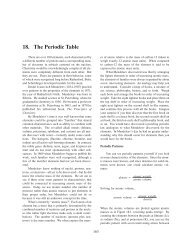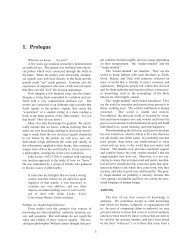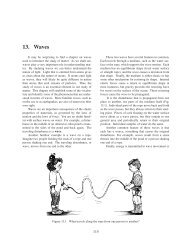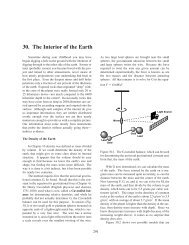You also want an ePaper? Increase the reach of your titles
YUMPU automatically turns print PDFs into web optimized ePapers that Google loves.
tion “states” that imply that one of the atoms has entirely<br />
lost one or more electrons <strong>and</strong> the other atom has<br />
taken full possession of one or more electrons. Ions will<br />
not be formed completely by elements near one another<br />
in the Periodic Table. The smaller nonmetal atom will<br />
pull harder on the electrons than the larger metal atom<br />
does, but the electrons will not leave entirely.<br />
Nevertheless, the pretense that they leave helps us write<br />
down the correct formula, so we keep the concept but<br />
change the name to oxidation number to remind ourselves<br />
that we may not be dealing with completely<br />
formed ions.<br />
In naming these salts, the metal is named first followed<br />
by the nonmetal with its last syllable changed to<br />
-ide: NaCl is sodium chloride, Li 2 O is lithium oxide,<br />
<strong>and</strong> Al 2 S 3 is aluminum sulfide.<br />
The elements chosen for the preceding examples<br />
usually can have only one oxidation number. Many<br />
other elements have at least two common oxidation<br />
numbers; the name must indicate which is the oxidation<br />
number of interest. One way to do this is to use Roman<br />
numerals in parentheses to indicate the oxidation state<br />
of the metal. For example, FeO would be named<br />
iron(II) oxide, <strong>and</strong> Fe 2 O 3 would be named iron(III)<br />
oxide.<br />
When two nonmetals are combined, it is not always<br />
clear from the oxidation numbers how many atoms are<br />
in the molecule, so the number of atoms of each element<br />
in the molecule is mentioned using the following prefixes:<br />
mono- for one, di- for two, tri- for three, <strong>and</strong><br />
tetra- for four. (Other prefixes are used for higher numbers.)<br />
Some examples are CO, carbon monoxide; CO 2 ,<br />
carbon dioxide; <strong>and</strong> N 2 O 3 , dinitrogen trioxide.<br />
Summary<br />
Elements can be divided into two categories: metals<br />
<strong>and</strong> nonmetals. In turn we can divide the types of<br />
chemical bonds into three categories: metals with metals<br />
(metallic bond), metals with nonmetals (ionic bond),<br />
<strong>and</strong> nonmetals with nonmetals (covalent bond). A distinctive<br />
class of physical characteristics is associated<br />
with each type of bond.<br />
In a solid metal the atoms are so close together that<br />
the orbits of the valence electrons overlap. Because the<br />
outer electrons are so loosely held, they can easily drift<br />
from one orbital to another through the overlapping<br />
regions to any part of the lump of metal. The freedom<br />
of the valence electrons to drift results in the following<br />
properties for metals bound by the metallic bond: good<br />
electrical conductivity, metallic luster, malleability,<br />
good thermal conductivity, high chemical reactivity,<br />
<strong>and</strong> readiness to form alloys.<br />
It is energetically favorable in metal-nonmetal<br />
reactions for the metal to give up valence electrons to<br />
the nonmetal, thus forming electrically charged ions.<br />
Electrically charged ions with opposite charges are then<br />
attracted to one another <strong>and</strong> become attached to one<br />
another in an ionic bond. Atoms that have lost electrons<br />
in ionic bonds are said to be in positive oxidation<br />
states. Atoms that have gained electrons in ionic bonds<br />
are said to be in negative oxidation states. The oxidation<br />
states are further characterized by the number of<br />
electrons gained or lost: –1 (for atoms that have gained<br />
one electron), +2 (for atoms that have lost two electrons),<br />
etc.<br />
Ionic compounds of a metal <strong>and</strong> a nonmetal are<br />
called salts. Salts are generally crystalline solids, transparent,<br />
brittle, white in color (although occasionally<br />
colored), electrically nonconducting as a solid, but conducting<br />
in water solutions or in melted form. These<br />
characteristics can be easily understood in terms of the<br />
nature of the ionic bond.<br />
Bonding between nonmetals (covalent bond) will<br />
be described in the next chapter.<br />
STUDY GUIDE<br />
<strong>Chapter</strong> <strong>20</strong>: <strong>Metals</strong> <strong>and</strong> <strong>Their</strong> <strong>Compounds</strong><br />
A. FUNDAMENTAL PRINCIPLES: No new fundamental<br />
principles.<br />
B MODELS, IDEAS, QUESTIONS, OR APPLICA-<br />
TIONS<br />
1. What useful groups are compounds often divided<br />
into?<br />
2. Under what conditions do atoms form metallic<br />
bonds?<br />
3. What are the properties of compounds held in<br />
metallic bonds <strong>and</strong> why do these compounds have<br />
such properties?<br />
4. Under what conditions do atoms form ionic bonds?<br />
5. What are the simplest rules needed to determine the<br />
primary oxidation states of different atoms?<br />
6. What are the properties of compounds held in ionic<br />
bonds, <strong>and</strong> why do these compounds have such<br />
properties?<br />
7. What procedure leads to the correct chemical formula<br />
for reactants formed in reactions involving<br />
compounds held together in ionic bonds?<br />
C. GLOSSARY<br />
1. Alloys: Alloys are mixtures of metals. <strong>Metals</strong><br />
readily form alloys within certain limits.<br />
2. Brittleness: A characteristic of ionic substances,<br />
such as salts, that readily shatter when struck a<br />
sharp blow.<br />
3. Electrical Conductivity: A measure of the degree<br />
to which a substance conducts an electrical current.<br />
<strong>Metals</strong> have a high electrical conductivity.<br />
4. Electrical Nonconductivity: A characterization of<br />
ionic substances, such as salts, that do not readily<br />
188








